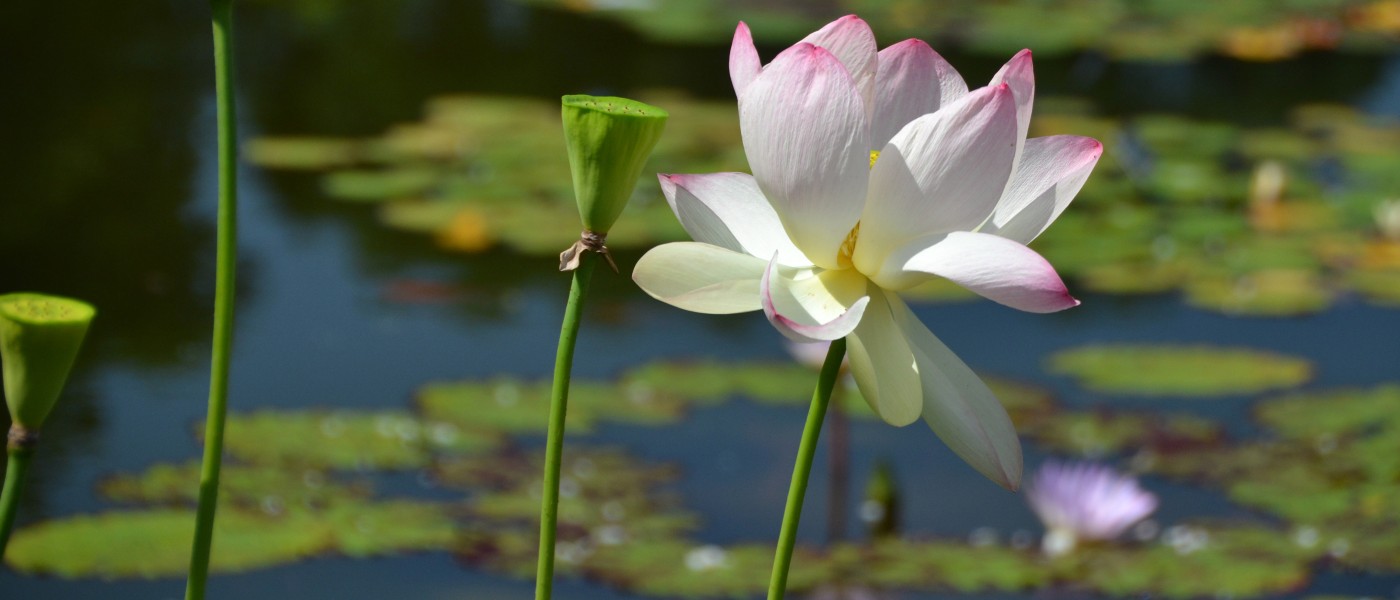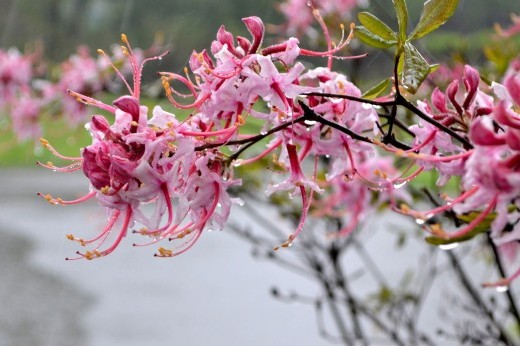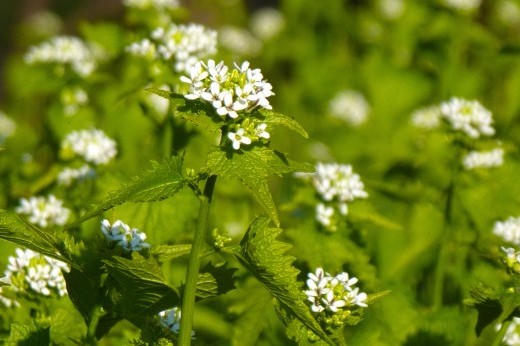Each summer, Brooklyn Botanic Garden’s Lily Pool Terrace lights up with a display of radiant lotuses. All of these cultivars are relatives of the species Nelumbo nucifera, whose common names include lotus, sacred lotus, and Asian lotus.
When you see these remarkable plants towering over the water, captivating in their symmetry and seeming to glow, it’s not surprising that they have played a role in many culinary, artistic, and spiritual traditions throughout history.
Getting to know Nelumbo nucifera
Nelumbo nucifera is an aquatic perennial plant. It thrives in subtropical biomes, with a native range that spans across Southeast Asia, Western Asia, and parts of Oceania (e.g., Western Australia and Papua New Guinea). It has been introduced and cultivated around the world, and there are established populations in the eastern United States.

At Brooklyn Botanic Garden, lotuses are grown in pots set on pedestals in the Lily Pools and Rose Arc Pool. Some of the cultivars here are hybrids crossed with the native Nelumbo lutea (American lotus), which has distinctive yellow flowers.
In the wild, Nelumbo nucifera grows from mud found at the bottom of lakes, rivers, and marshes. It reproduces by seed and by rhizomes, which are modified underground stems that behave like roots. Its flowers range from white to pink and can grow about one foot wide; the number of petals varies.
Lotuses are sometimes mistaken for water-lilies (Nymphaea sp.), which bloom alongside them at Brooklyn Botanic Garden. An easy way to tell them apart: Lotuses flower atop long stems, while water-lily blossoms usually stay closer to the water. Lotus flowers’ female parts are enclosed in a yellow cone-like structure at the center of the bloom. That structure later becomes a large seed pod.
N. nucifera has several fascinating qualities. For one, its leaves are notably hydrophobic (i.e. water-repellent), meaning that even in the murkiest swamps, they remain pristinely clean. This self-cleaning ability is known as the “lotus effect,” and has inspired new technologies and materials. Sacred lotuses are also famous for their longevity. UCLA researchers found 1,300-year-old lotus seeds while excavating an ancient riverbed in northeastern China, and successfully germinated them.

Though N. nucifera plays an important ecological role in its native aquatic habitats, in the United States it is considered potentially invasive and is not recommended for planting in some areas. With the ability to spread in dense mats, it may pose a threat to native aquatic vegetation and dependent animals.
“Rising from the mud yet remaining unstained”
The sacred lotus has been cultivated in Asia for its ornamental, edible, and medicinal qualities for thousands of years, and has extensive cultural significance in the region.
You can find sacred lotuses in classical literature, poetry, and religious texts, in the design of both ancient and contemporary structures like Angkor Wat in Cambodia and the Lotus Temple in India, and planted in landscapes and gardens. A fabric made of lotus stems, called lotus silk, is produced by expert silk makers in Vietnam, Myanmar, and Cambodia and sold for high prices around the world.

The lotus is an important symbol in dharmic religions like Hinduism, Buddhism, Jainism, and Sikhism. It is believed that when the Buddha, Siddhartha Gautama, was born, lotuses bloomed to mark his first seven steps. One of the most important scriptures in Mahāyāna Buddhism is the Saddharmapundarikasutra, or the Lotus Sutra.
The lotus has many symbolic meanings, from enlightenment to immortality to beauty and fertility. In his well-known essay “On the Love of the Lotus,” 11th century Neo-Confucian philosopher and poet Zhou Dunyi highlighted the flower as a symbol of moral purity:
“I love only the lotus, for rising from the mud yet remaining unstained; bathed by pure currents and yet not seductive.”

The sacred lotus is also the national flower of India and Vietnam, and part of the national flag of Macau. Every June, Macau hosts a Lotus Flower Festival. Lotus-themed celebrations also take place in U.S. cities like Los Angeles and Washington D.C., highlighting the flower and its connection to the cultural heritage of various Asian American Pacific Islander communities.
Helpers in healing (and eating)
Sacred lotus is widely used across Asian traditional, complementary, and alternative medicine (TCAM) systems to treat a variety of diseases and conditions. Depending on the plant part, sacred lotus is used to help with pain relief, skin issues, urinary problems, gastrointestinal regulation, oral health, and more.
All parts of this remarkable plant are edible, too. The rhizome is acclaimed for its crisp texture and subtle flavor profile, allowing for diverse preparations. In Chinese, Japanese, Korean, and Indian cuisine, you can find many different pickle recipes that range from sweet to spicy and sour.
.jpg)
Lotus root, or nadru, is a core ingredient in Kashmiri cuisine. It is fried as a snack (nadru monje) served alongside chai, or added to yogurt sauces (nadru yakhni) and rich curries. And for those with a sweet tooth, lotus seed paste is a typical filling for the delicious mooncakes eaten during the Mid-Autumn Festival, which originated in China. These treats can be found in bakeries across New York City.
BBG’s lotuses are ornamental and not harvested as food—though Canada geese make regular attempts to swoop down and snack on their rhizomes! Next time you visit in the summertime, stroll over to Lily Pool Terrace and take in these magical blooms while they last.
Further reading
Lovely Lotuses, Brooklyn Botanic Garden
Sacred Lotus, Kew Gardens
Lotus (Nelumbo nucifera): a multidisciplinary review of its cultural, ecological, and nutraceutical significance, Bioresources and Bioprocessing



